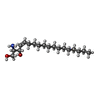+Search query
-Structure paper
| Title | Molecular basis of Coxsackievirus A10 entry using the two-in-one attachment and uncoating receptor KRM1. |
|---|---|
| Journal, issue, pages | Proc Natl Acad Sci U S A, Vol. 117, Issue 31, Page 18711-18718, Year 2020 |
| Publish date | Aug 4, 2020 |
 Authors Authors | Yingzi Cui / Ruchao Peng / Hao Song / Zhou Tong / Xiao Qu / Sheng Liu / Xin Zhao / Yan Chai / Peiyi Wang / George F Gao / Jianxun Qi /  |
| PubMed Abstract | KREMEN1 (KRM1) has been identified as a functional receptor for Coxsackievirus A10 (CV-A10), a causative agent of hand-foot-and-mouth disease (HFMD), which poses a great threat to infants globally. ...KREMEN1 (KRM1) has been identified as a functional receptor for Coxsackievirus A10 (CV-A10), a causative agent of hand-foot-and-mouth disease (HFMD), which poses a great threat to infants globally. However, the underlying mechanisms for the viral entry process are not well understood. Here we determined the atomic structures of different forms of CV-A10 viral particles and its complex with KRM1 in both neutral and acidic conditions. These structures reveal that KRM1 selectively binds to the mature viral particle above the canyon of the viral protein 1 (VP1) subunit and contacts across two adjacent asymmetry units. The key residues for receptor binding are conserved among most KRM1-dependent enteroviruses, suggesting a uniform mechanism for receptor binding. Moreover, the binding of KRM1 induces the release of pocket factor, a process accelerated under acidic conditions. Further biochemical studies confirmed that receptor binding at acidic pH enabled CV-A10 virion uncoating in vitro. Taken together, these findings provide high-resolution snapshots of CV-A10 entry and identify KRM1 as a two-in-one receptor for enterovirus infection. |
 External links External links |  Proc Natl Acad Sci U S A / Proc Natl Acad Sci U S A /  PubMed:32690697 / PubMed:32690697 /  PubMed Central PubMed Central |
| Methods | EM (single particle) |
| Resolution | 3.0 - 3.6 Å |
| Structure data | EMDB-30253, PDB-7bzn: EMDB-30254, PDB-7bzo: EMDB-30259, PDB-7bzt: EMDB-30260, PDB-7bzu: EMDB-30287, PDB-7c4t: EMDB-30290, PDB-7c4w: EMDB-30291, PDB-7c4y: EMDB-30292, PDB-7c4z: |
| Chemicals |  ChemComp-SPH:  ChemComp-NAG: |
| Source |
|
 Keywords Keywords | VIRUS / Picornavirus / Coxsackievirus A10 / pH 7.4 / mature particle / pH 5.5 / KRM1 / complex / A particle / empty particle |
 Movie
Movie Controller
Controller Structure viewers
Structure viewers About Yorodumi Papers
About Yorodumi Papers




















 coxsackievirus a10
coxsackievirus a10 homo sapiens (human)
homo sapiens (human)